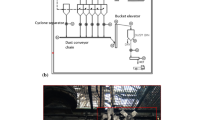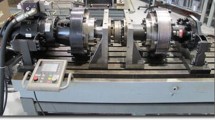Abstract
In recent years, the failure of winch shafts has garnered significant attention due to their critical role in various industrial applications. This study aims to investigate the fracture cause of a 40CrNiMoA winch shaft, which had been used for three years. A comprehensive analysis, including visual inspection, fractography and metallography, conventional mechanical property testing, CAE simulation was conducted to identify the primary factors contributing to the shaft failure. The results show that the shaft failure was a rotating bending fatigue fracture event. A combination of manufacturing defects, material properties and operating conditions led to the fracture of the winch shaft. The CAE simulation results indicate that the right-angle radius at the shaft shoulder forms a stress concentration effect, and the nominal stress at this location exceeds the fatigue strength limit, leading to the initiation of fatigue cracks. The presence of upper bainite structure in the material results in decreased mechanical properties, which to some extent promotes fatigue cracking.










Similar content being viewed by others
Data Availability
The data that support the findings of this study are available from the corresponding author upon reasonable request. E-mail:550484845@qq.com, 136543280@qq.com.
References
M. Savkovi, M. Gai, D. Petrovi, N. Zdravkovi, R. Pljaki, Analysis of the drive shaft fracture of the bucket wheel excavator. Eng. Fail. Anal. 20(1), 105–117 (2012)
P.H. Chen, J.J. Zou, F. Li, Fracture failure analysis of fuel pump transmission shaft of dual-fuel engine. MATEC Web Conf. 95, 04003 (2017)
X.J. Xu, S.S. Kim, K.M. Chen, Q.F. Luo, Analysis of the failure of turbocharger shaft bearing in diesel engines. Key Eng. Mater. 297–300(Pt2), 1376–1381 (2005)
C.L.L.X.B. Song, Z.Q. Bai, X. Xing, X.R. Kuang, Fracture analysis of a pulley shaft for the linear motor oil pumping unit in western oilfield of China. Eng. Fail. Anal. 124(1), 139–149 (2021)
Y. Liu, Z. Lian, J. Zou, C. Deng, Y. He, Fracture failure analysis and research on thread joint of drive shaft shell of positive displacement motor. Eng. Fail. Anal. 118, 104805–104812 (2020)
M. Madia, S. Beretta, U. Zerbst, An investigation on the influence of rotary bending and press fitting on stress intensity factors and fatigue crack growth in railway axles. Eng. Fract. Mech. 75(8), 1906–1920 (2008)
K.O. Haeng-Nam, Behavior of mirror-like region of sintered Si3N4 under rotary bending and static fatigue. J. Ceram. Soc. Jpn. 97(1151), 599–603 (2010)
J. Schijve, Fatigue of structures and materials in the 20th century and the state of the art. Mater. Sci. 25(8), 679–702 (2003)
Y. Yamauchi, T. Miyajima, S. Ito, K. Kubo, Evaluation of fatigue behavior of ceramics toughened by grain bridging mechanism. J. Ceram. Soc. Jpn. 102(1185), 442–448 (2010)
Anonymous. 2019. Design and selection of components for enclosed gear drives, vol AGMA 6001-F19-2019. US-AGMA.
Z. ShaoBian, Resisting fatigue design. (Mechanical Industry Press, Beijing, 1994)
H. Wu, S. Zhong, H. Cheng, Y. Cao, G. Zhu, Analysis of the causes of fracture of hard wire from high-carbon steel 65C. Met. Sci. Heat. Treat. 63(3), 178–182 (2021)
Y. Sawaki, N. Aoyama, T. Kawasaki, Determination of fatigue fracture toughness by conventional rotary bending specimen. Int. J. Fract. 26(1), 46–52 (1984)
J. Zhang, X. Li, B. Yang, B. Wu, S. Zhu, Fatigue properties and fatigue strength evaluation of railway axle steel: effect of micro-shot peening and artificial defect. Int. J. Fatigue. 132, 105–109 (2019)
K. Shiozaw, T. Hasegawa, Y. Kashiwagi, L. Lu, Very high cycle fatigue properties of bearing steel under axial loading condition. Int. J. Fatigue. 31(5), 880–888 (2009)
L. Jiheng, Z. Ming, Q. Derong, Y. Hucheng, Substructure of widmanstatten ferrite and its effect on crack propagation. Acta Mech. Sin. 22(4), 345–350 (1986)
Acknowledgments
The author has obtained the Science and Technology Plan of Shandong Higher Education Institutions (Approval No. J17KB026) and the Shandong Vocational Education Teaching Reform Research Project (Approval No. 2015252)
Author information
Authors and Affiliations
Corresponding author
Additional information
Publisher's Note
Springer Nature remains neutral with regard to jurisdictional claims in published maps and institutional affiliations.
Rights and permissions
Springer Nature or its licensor (e.g. a society or other partner) holds exclusive rights to this article under a publishing agreement with the author(s) or other rightsholder(s); author self-archiving of the accepted manuscript version of this article is solely governed by the terms of such publishing agreement and applicable law.
About this article
Cite this article
Liu, Y., Ma, G. & Liu, R. Analysis of the Fracture Cause of the 40CrNiMoA Winch Shaft. J Fail. Anal. and Preven. 23, 1782–1788 (2023). https://doi.org/10.1007/s11668-023-01715-7
Received:
Revised:
Accepted:
Published:
Issue Date:
DOI: https://doi.org/10.1007/s11668-023-01715-7




